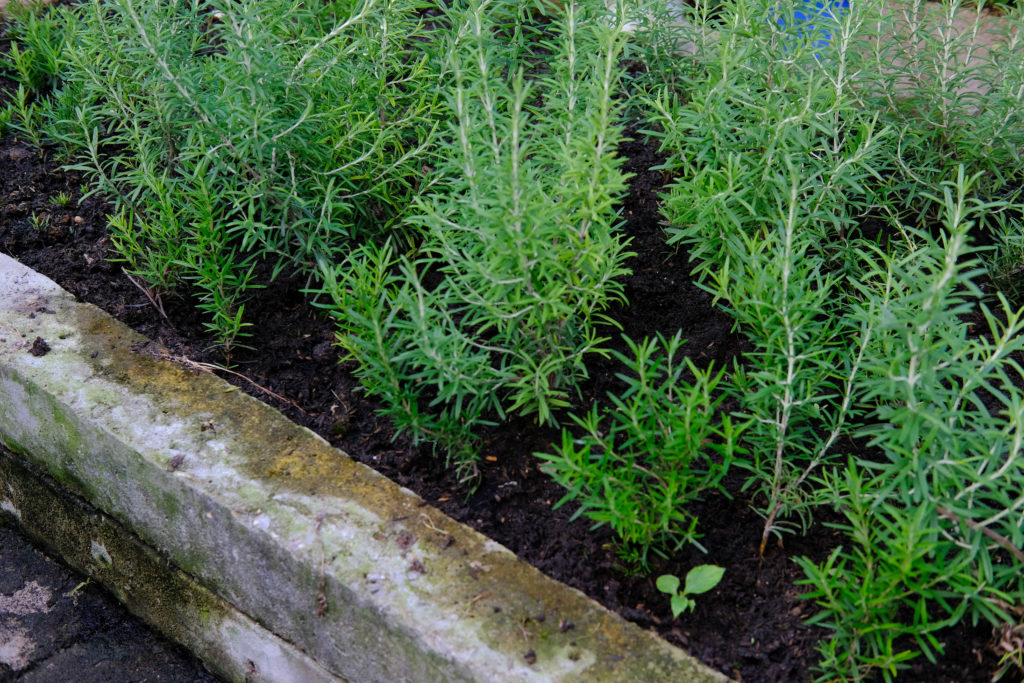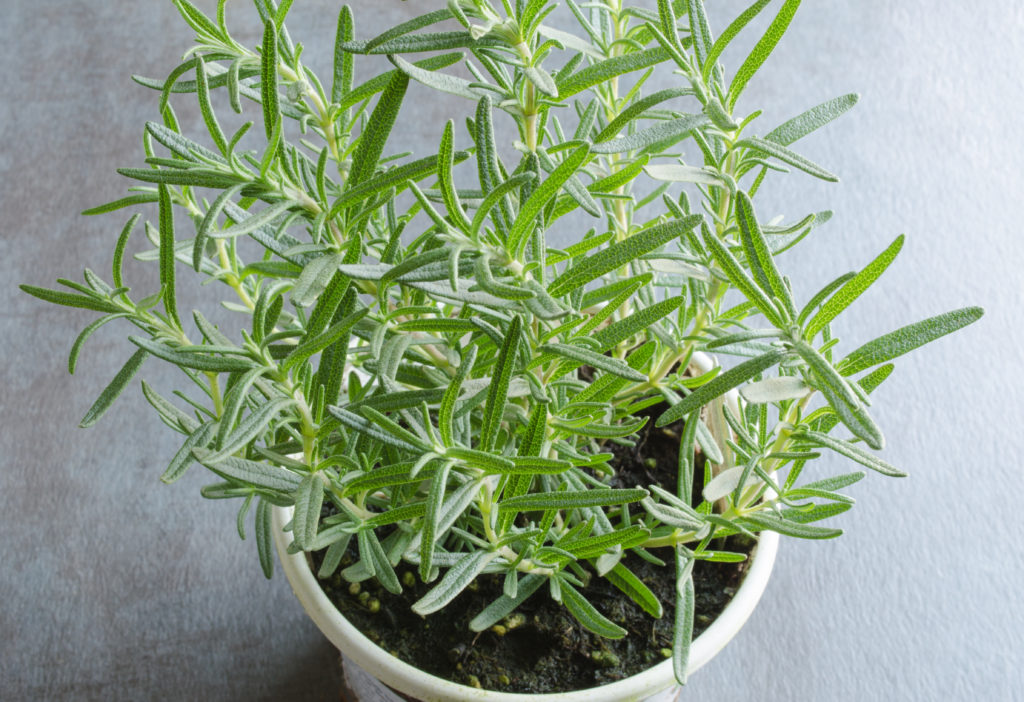You can learn how to grow rosemary in a few minutes. Rosemary is commonly used in the kitchen as a flavoring. The spicy, aromatic leaves can be used fresh or dried in many dishes flavoring beef, veal, pork, lamb, stuffings, soups, sauces, and salad dressings. Rosemary is a woody, evergreen perennial herb that can be grown as an annual. Rosemary grows best in warmer climates; it is a Mediterranean region native. In cold winter regions, grow rosemary indoors as a potted annual.
Here is your complete guide to growing rosemary.
Where to plant rosemary
- Best location: Grow rosemary in full sun.
- Soil preparation: Rosemary grows best in light, well-drained soil. Add aged compost to the planting bed ahead of planting. Rosemary will endure poor soil as long as it is well-drained. Rosemary prefers a soil pH of 6.5 to 7.0.
Articles of interest:
- How to Grow Herbs
- How to Start an Herb Garden
- Best Herbs for Container Growing
- Herbs for Cool Season Growing
- Grow 20 Herbs for Cooking

When to plant rosemary
- Seed starting indoors: Sow rosemary seeds indoors in spring. Sow seed in potting soil under fluorescent lights. Seed can take up to 21 days to germinate at 65°F (18°C) Rosemary can also be grown from cuttings. Start cuttings from new growth in spring or late summer.
- Transplanting to the garden: Set out rosemary transplants after the last spring frost.
- Outdoor planting time: Rosemary seeds can be started outdoors after the last spring frost. You can start new plants by layering stems during the summer; cover an herbaceous section of stem with soil and it will root in place to create a new plant.
- Planting depth: Sow rosemary seed ¼ to ½ inch deep.
- Spacing: Space plants 18 to 36 inches apart.
- How much to plant: Grow one rosemary plant for cooking; grow 2 to 3 plants for preserving.
Rosemary companion plants
- Companion planting: Grow rosemary with lavender, sage, hyssop, and Santolina. Rosemary’s fragrance is said to repel cabbage flies, root maggot flies, and other flying pests.
Watering and feeding rosemary
- Watering: Keep the soil just moist as rosemary becomes established; once established, water rosemary infrequently. Rosemary is sensitive to overwatering and under-watering. That said it’s best to not let plantings dry out.
- Feeding: Rosemary is a light feeder. Keep planting beds fed with aged compost. Apply a foliar spray of liquid seaweed or kelp extracts two or three times during the growing season.
Rosemary care and maintenance
- Care: To encourage fresh growth, trim rosemary back several inches twice each season. Prune plants after the flowers have faded.
- Mulching: Mulch around rosemary with aged compost or chopped leaves to slow soil moisture evaporation.

Container growing rosemary
- Container growing: Rosemary can be container grown as an annual or as a perennial. Choose a container at least 12 inches in diameter and at least 8 inches deep. Grow rosemary indoors under fluorescent light set directly above the plants.
- Winter growing: Rosemary may not overwinter well when the weather is wet and cold for prolonged periods. Protect rosemary from harsh, cold winters (colder than Zone 7) by moving it indoors or into a cold frame or greenhouse when freezing weather threatens; keep greenhouse plants at 45°F or warmer. Indoor plants need plenty of light and high humidity; dry heat will cause leaf drop. Trim plants to shape after flowering to overwinter indoors. If you leave rosemary in place outdoors in cold winter regions, protect the plant with a layer of evergreen boughs, chopped leaves, or straw. Larger plants will overwinter better outdoors than small ones.
Rosemary pests and diseases
- Pests: Mealybugs and scale may be occasional problems where plants are stressed. If growing rosemary indoors watch for scale and wipe them from foliage with a cotton ball soaked with rubbing alcohol.
- Diseases: In humid climates, rosemary can be susceptible to fungal root rot. Amend the soil with aged compost and do not grow plants too close together.
How to harvest rosemary
- When to harvest: Snip fresh foliage as needed all year; rosemary leaves are most aromatic just before the plant blooms.
- How to harvest: Harvest leaves and branches with a garden pruner. Take 4 to 6-inch sprigs from the tips of the branches for kitchen use. Strip the leaves from the stems. Never prune more than one-third of the plant at one time; severe pruning will stress the plant.
Rosemary in the kitchen
- Flavor and aroma: Rosemary has a mild camphor flavor. When used to excess, rosemary will have an acrid taste. Add a small amount then adjust to taste.
- Leaves: Use fresh or dried leaves in sauces, stews, soups, and also meat and poultry dishes. Rosemary enhances the flavor of tomatoes, spinach, peas, mushrooms, squash, cheese, and eggs. Add rosemary to marinades, salad dressings, and cream sauces.
- Stems: Toss rosemary stems on the coals to flavor barbeques just before the meat is finished; the smoke will impart rosemary flavor to the meat. Use stems as a brush to apply barbecue sauce to chicken.
- Flowers: Flowers can be sprinkled on salads or used in herbs butter or cream cheese spreads.
- Culinary compliments: Rosemary compliments chives, thyme, chervil, parsley, and bay.
Preserving and storing rosemary
- Refrigeration: Wrap sprigs in a clean towel; they will stay fresh in the refrigerator crisper for as long as 2 weeks.
- Drying: Rosemary can be dried for storing by setting the leaves on a screen or drying tray in a shady, warm place. Gather bunches and hang them upside down in a cool, shady place.
- Freezing: Rosemary leaves can be frozen in a freezer bag.
- Storing: Store dried rosemary leaves in an airtight container out of sunlight.

Rosemary propagation
- Seed: Rosemary seed is difficult to germinate. Sow seed in potting soil under fluorescent lights. Seeds can take up to 21 days to germinate at 65°
- Cuttings: Start stem cuttings in spring or late summer or fall. To start rosemary from cuttings snip a 3-inch cutting from the top of a branch and remove the leaves on the lower third, dip the cut end in a rooting hormone to encourage root formation, and firm the stem into a light potting mix.
- Layering: Branches that touch the ground usually form roots that can become independent plants. Layer stems in early summer.
Rosemary varieties to grow
- Rosmarinus prostrates is a low-growing trailing variety about 3 feet tall. This variety will sprawl. The flowers of prostrate rosemary are a deeper blue than upright varieties.
- ‘Tuscan Blue’ is a rigid, upright variety that can grow to 6 feet tall or more; the flowers are dark blue.
- ‘Albus’ has white flowers.
- ‘Collingwood Ingram’ has gracefully curved stems and grows 2 to 3 feet tall.
- ‘Lockwood de Forest’ grows 18 to 24 inches tall and has dark blue flowers.
Get to know rosemary
- Botanical name and family: Rosmarinus officinalis (Lamiaceae—mint family)
- Origin: Mediterranean region
- Type of plant: Rosemary is a woody, evergreen perennial; rosemary plants can live for 15 or more years with little care.
- Growing season: Summer
- Growing zones: Zones 8 to 11
- Hardiness: Rosemary is cold hardy to 10°
- Plant form and size: Rosemary grows as a shrub and can vary in growth habits from low-growing, rounded, and spreading to stiff and upright to 6 feet tall. Rosemary stems become woody and rugged-looking with age. Branches tend to sweep outward and upward.
- Flowers: Rosemary has small clusters of pale blue, lavender flowers ¼ to ½ inch across in whorls on short spikes.
- Bloom time: Flowers winter through spring.
- Leaves: Glossy dark green resinous aromatic narrow needle-like leaves about one inch long that are grayish-white on the underside.
More tips at Grow 20 Herbs for Cooking.
Also of interest:
- Anise
- Anise Hyssop
- Arugula
- Basil
- Bay
- Bee Balm
- Borage
- Calendula
- Caraway
- Catnip
- Chamomile
- Chervil
- Chives
- Cilantro-Coriander
- Clary
- Costmary
- Cress
- Dill
- Fennel, Sweet
- Horseradish
- Hyssop
- Lavender
- Lemon Balm
- Lemongrass
- Lemon Verbena
- Lovage
- Marjoram
- Mint
- Nasturtium
- Oregano
- Parsley
- Perilla
- Rosemary
- Sage
- Salad Burnet
- Savory
- Scented Geranium
- Shiso
- Sorrel
- Stevia
- Sweet Cicely
- Tarragon
- Thyme
Related articles:
Best Herbs for Container Growing
Planning the Home Fruit Garden
Garden Planning Books at Amazon:
- Vegetable Garden Almanac & Planner
- Kitchen Garden Grower’s Guide Vegetable Encyclopedia
- Vegetable Garden Grower’s Guide
- Tomato Grower’s Answer Book















